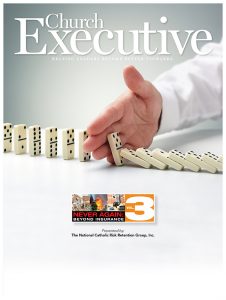
A 6-step process to making it a reality at your church
By Michael J. Bemi
![]() Our series on moving “beyond insurance” has, so far, identified and examined all the critical elements and related processes to enable an insured entity to “move beyond” insurance.
Our series on moving “beyond insurance” has, so far, identified and examined all the critical elements and related processes to enable an insured entity to “move beyond” insurance.
But, realistically, can we ever really move beyond insurance?
After all, even the largest insurance companies still buy insurance for their own operations, in a process known as reinsurance. Given the potential for catastrophic events or unpredictable “black swan” occurrences, the ultimate costs of self-insuring could become enormous. Even if a faith-based entity were able to amass the resources to finance these costs, would that represent good stewardship, or would the church’s mission be better served by investing these resources and finances into its ministries?
The good news is that there is a “middle road” that can be followed to achieve excellence of both ministerial and risk management objectives, without paying too much for necessary insurance. That “middle road” requires implementation of, and consistent adherence to, the “roadmap” elements and processes identified in this series of articles.
In other words, and by way of review:
#1: You first need to Identify, Analyze and Evaluate the ministries, non-ministerial operations, assets (human, physical and financial) and environment that expose

your church to loss. Note that if your ministry is very large and has been well-established for many years, involving a certified actuary can be very helpful in assessing the probable frequency and severity of your future claims.
#2: You need to determine the relative cost to benefit relationship of all your ministries or proposed ministries, with the goal of perhaps deciding to prevent losses and claims via Risk Avoidance. Remember that a foundational principle of risk management is to “never risk a lot for a little.”
#3: Using the information produced by steps 1 and 2 (including actuarial advice for very large entities), you can determine a reasonable level of initial Risk Retention that will reduce your insurance premiums, improve your cash flow, and allow you to choose how you employ your premium savings. Note here that it is highly recommended that you use a substantial portion of those savings to establish a “loss fund” to cover payments for predictable loss experience, without damaging your regular cash flow. Over time, your retention level can increase, but only if you employ the remaining several steps.
#4: All your sincere efforts and good intentions in steps 1 through 3 will be for naught, if you do not seriously undertake and continuously employ Risk Control. This will prevent losses from occurring and mitigate the severity of losses you cannot prevent.
#5: Similarly, we must recognize that in this imperfect world in which we live and minister to others, it is impossible to prevent every loss and related claim. We then must turn our attention to and concern ourselves with excellent Claims Management. To accomplish this, we must successfully “walk the tightrope” that exists between compassionately, fairly, pastorally and expeditiously tending to victims we have created, while avoiding the temptation to “roll over and play dead” in relation to unreasonable demands by victims and their legal representatives, when the extent of your church’s negligence or the extent of the victim’s damages, or both, are questionable and debatable.
#6: Next, we use Contractual Risk Transfer. This ensures that the entity most able and best equipped to control operations and activities performed on your behalf is also the entity that is contractually responsible for losses / claims that arise in the performance of their work. It also confirms that they make your faith-based entity an Additional Insured under their coverage. The coverage must be validated to ensure consistency with your standards of quality and extent, with evidence of insurance carrier excellence.
Finally, while performing all six steps, you are in a position to determine — with professional assistance, if you deem — the amount of excess insurance to purchase for catastrophic and highly unpredictable loss events.
Michael J. Bemi is president & CEO of The National Catholic Risk Retention Group, Inc. (Lisle, IL) — a recognized leader in risk management. To learn more about available coverage — and to get valuable tools, facts and statistics — visit www.tncrrg.org.


